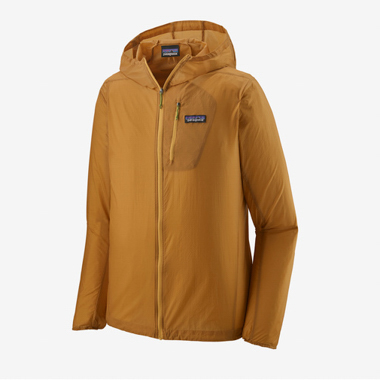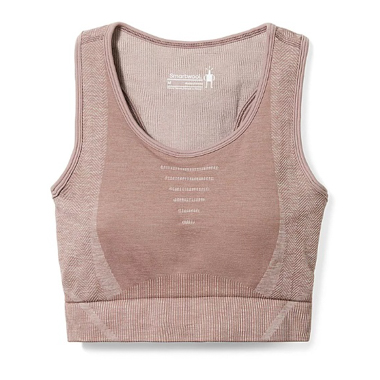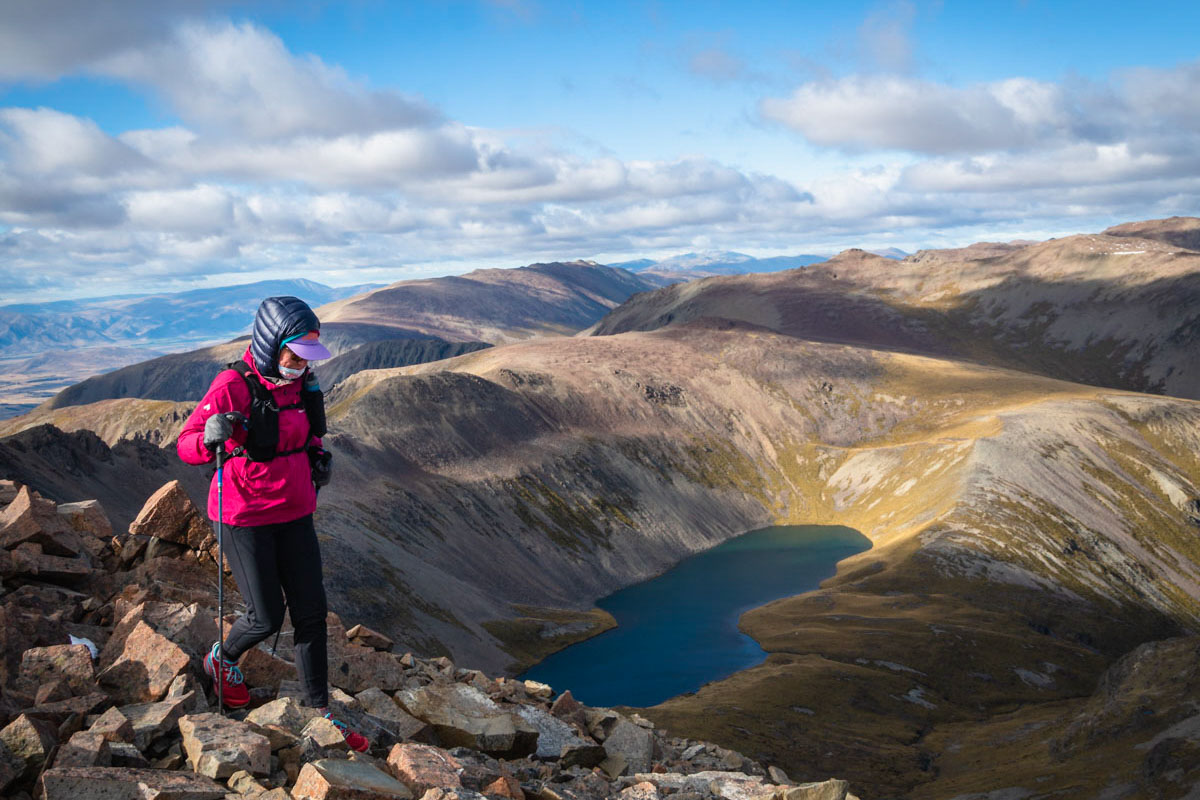When we think of running in the winter, we think of friends meeting on dark, cold mornings when our beds feel oh-so-warm. We think of how the chilly air feels during those first 10 minutes and how softly yet suddenly the cold wanes, and we feel toasty. The best cold-weather running gear will let you run outdoors regardless of the winter weather. Running in the wintertime is magical, and the iRunFar team wants you to experience that joy!
With this guide, we share some of our favorite winter pieces to help you run safely and comfortably through the winter. Our team has tested these pieces of gear over multiple years and seasons, on various types of terrain, around the world, and in diverse winter conditions. We are excited to share these recommendations, which were selected for their strengths and versatility.
Whether you need a winter running jacket like the Patagonia Houdini Jacket or gloves like the Trailheads Convertible Zip Mitts for the very coldest conditions, we have recommendations to keep you warm and comfortable.
You can also skip down to read our recommendations on choosing the right cold-weather running gear for you, our answers to your frequently asked questions about cold-weather running gear, and how we put this guide together.
Best Cold Weather Running Gear
- Best Winter Running Shoes for All Conditions: Salomon Speedcross 6, Salomon Speedcross 6 Gore-Tex
- Best Winter Running Shoes for Packed Snow: Hoka Speedgoat 6 and Hoka Speedgoat 6 GTX
- Best Winter Traction Device for Off-Road Running: Black Diamond Distance Spike
- Best Winter Traction Device for Road Running in Mixed Conditions: Kahtoola EXOspikes
- Best Hydration Pack for Winter Running: Salomon Adv Skin 12
- Best Running Belt: Naked Running Band
- Best Windbreaker Jacket: Patagonia Houdini Jacket
- Best Rain Jacket: Outdoor Research Helium Rain Jacket
- Best Winter Running Jacket: Patagonia Nano-Air Hoody
- Best Hybrid Jacket for Winter Running: Patagonia Airshed Pro Pullover
- Best Base Layer Shirt for Winter Running: Smartwool Classic All-Season Merino Base Layer 1/4 Zip
- Best Mid-Layer Shirt for Winter Running: Janji Rover Merino Hoodie
- Best Winter Running Tights: Patagonia Endless Run Tights
- Best Insulated Winter Running Tights: Gorewear R3 Thermo Tights
- Best Headband for Cold Weather Running: Buff Dryflx Headband
- Best Winter Running Beanie: Sauce Swift Toque
- Best Brimmed Hat for Winter Running: Buff Pack Merino Fleece Cap
- Best Gloves for Winter Running: Ultimate Direction Ultra Flip Glove
- Best Gloves for Very Cold Conditions: Trailheads Convertible Zip Mitts
- Best Sports Bra for Cold Weather: Smartwool Women’s Intraknit Racerback Bra
- Best Wool Socks for Cold Weather: Smartwool Run Cold Weather Targeted Cushion Crew Socks
- Best Headlamp for Winter Running: Petzl Iko Core
- Best Sunglasses for Winter Running: Smith Motive

Winter running often requires significantly more gear, including a headlamp, warm jacket, gloves, and head covering. Photo: iRunFar/Andy Cochrane
Best Winter Running Shoes for All Conditions: Salomon Speedcross 6 ($145) and Speedcross 6 Gore-Tex ($165)
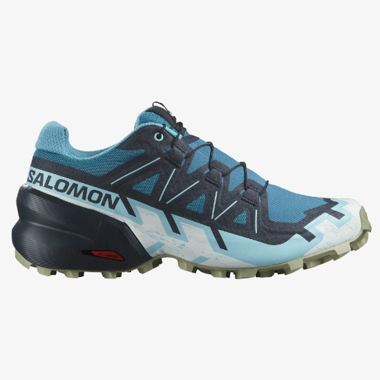 The Salomon Speedcross 6 and the Salomon Speedcross 6 Gore-Tex are our top picks for general, all-around, variable-terrain winter running shoes. For most winter conditions and sometimes during the shoulder seasons — hello, mud! — runners prioritize shoes with lugs and the traction they provide. We’ve named these the best shoes for mud in our best trail running shoes guide, and the big lugs also make them great for snow. The Gore-Tex version provides the additional benefit of being waterproof.
The Salomon Speedcross 6 and the Salomon Speedcross 6 Gore-Tex are our top picks for general, all-around, variable-terrain winter running shoes. For most winter conditions and sometimes during the shoulder seasons — hello, mud! — runners prioritize shoes with lugs and the traction they provide. We’ve named these the best shoes for mud in our best trail running shoes guide, and the big lugs also make them great for snow. The Gore-Tex version provides the additional benefit of being waterproof.
These shoes have Salomon’s notoriously grippy outsole, which helps with traction on nearly every surface. They are also built with five-millimeter multidirectional lugs to help dig into and generate grip in soft snow. We found these shoes to perform well on runs where we encountered a variety of ground conditions, including soft snow, mud, and wet ground.
They aren’t the lightest shoes, though this version is about an ounce lighter than the previous one. The tightly woven ripstop upper and durable outsole make these shoes incredibly protective, a feature we think is more important in a winter running shoe than weight. Salomon shoes tend to be on the firm side with a nimble footprint. This is a definite strength when navigating sloshy, slippery terrain.
Shop the Women's Salomon Speedcross 6Shop the Men's Salomon Speedcross 6Shop the Women's Salomon Speedcross 6 Gore-TexShop the Men's Salomon Speedcross 6 Gore-Tex
Best Winter Running Shoes for Packed Snow: Hoka Speedgoat 6 ($155) and Hoka Speedgoat 6 GTX ($180)
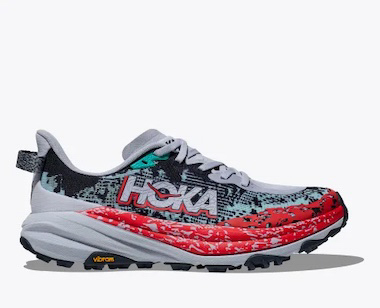 With the new Hoka Speedgoat 6, the brand has pivoted away from the softer upper of the prior version of the shoe and returned to a more structured shoe reminiscent of the Speedgoat 4. We appreciate this change when it comes to running on uneven surfaces, such as snow. The Speedgoat line has always been one of our favorites for running on snow due to its grippy outsole, stability, and ability to perform on aggressive terrain. For this new version of the shoe, Hoka has put a firmer and lighter foam into the midsole, which increases the feeling of rebound when running on harder surfaces. It also reduces the overall squishy feeling of running on snow.
With the new Hoka Speedgoat 6, the brand has pivoted away from the softer upper of the prior version of the shoe and returned to a more structured shoe reminiscent of the Speedgoat 4. We appreciate this change when it comes to running on uneven surfaces, such as snow. The Speedgoat line has always been one of our favorites for running on snow due to its grippy outsole, stability, and ability to perform on aggressive terrain. For this new version of the shoe, Hoka has put a firmer and lighter foam into the midsole, which increases the feeling of rebound when running on harder surfaces. It also reduces the overall squishy feeling of running on snow.
Hoka also makes a Gore-Tex version of this shoe, the Hoka Speedgoat 6 GTX. While we haven’t had a chance to take this shoe out on snowy runs, we expect it will perform similarly to its predecessor and excel on groomed trails and urban singletrack. We’ll update this guide after thorough testing.
Like the Salomon Speedcross 6 reviewed above, the Speedgoat 6 has five-millimeter lugs for traction but carries a slightly larger snowshoe-esque footprint and more cushion. This provides somewhat more floatation than a narrower shoe. The shoe’s drop has increased from 4 to 5 millimeters, but we can’t really tell the difference.
We featured this shoe in our Best Trail Running Shoes guide, and you can also read our in-depth Hoka Speedgoat 6 review.
Shop the Women's Hoka Speedgoat 6Shop the Men's Hoka Speedgoat 6Shop the Women's Hoka Speedgoat 6 GTXShop the Men's Hoka Speedgoat 6 GTX
Best Winter Traction Device for Off-Road Running: Black Diamond Distance Spike ($100)
Not long after hitting the market, the Black Diamond Distance Spike became the go-to choice for the iRunFar team. The design is reminiscent of a mountaineering crampon, with a rubber wrap around the back and sides of the shoes, a fabric toe cap, and a pull tab at the heel to make it easy to put on. The device securely fits on shoes and provides plenty of grip on snow and ice, even on steep slopes. We trusted them in conditions where we were nervous about using other similar traction devices.
Considering its traction and toe coverage, the Distance Spike is exceptionally light. In addition to its 14 eight-millimeter-long spikes, this design cuts the weight nearly in half compared to traditional full-spike traction devices available today. The spikes are made of stainless steel and heat-treated for strength, corrosion, and wear resistance.
Read our in-depth Black Diamond Distance Spike review to learn why the iRunFar team loves this traction device. Unsurprisingly, these have also taken a top spot in our Best Winter Running Traction Devices guide.
Shop the Black Diamond Distance Spike
A view of the Black Diamond Distance Spike with its innovative, weight-saving fabric toe cap. Photo: iRunFar/Bryon Powell
Best Winter Traction Device for Road Running in Mixed Conditions: Kahtoola EXOspikes ($65)
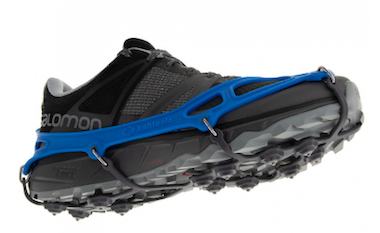 Not all winter runs are on constantly slippery conditions, and the tungsten carbide tips atop five-millimeter lugs of the Kahtoola EXOspikes provide enough grip on soft or slippery surfaces without being overkill. The EXOspikes have a low profile with tiny metal nubs and a rubber wrap that easily goes over the sole of any shoe. These are a great option if you’re running over slush, a bit of ice, or crusty forest roads. While they’re uncomfortable on dry pavement or other very hard surfaces, they’re easy to take on and off as conditions change.
Not all winter runs are on constantly slippery conditions, and the tungsten carbide tips atop five-millimeter lugs of the Kahtoola EXOspikes provide enough grip on soft or slippery surfaces without being overkill. The EXOspikes have a low profile with tiny metal nubs and a rubber wrap that easily goes over the sole of any shoe. These are a great option if you’re running over slush, a bit of ice, or crusty forest roads. While they’re uncomfortable on dry pavement or other very hard surfaces, they’re easy to take on and off as conditions change.
These traction devices are very light despite their 12 spikes and afford stability on all kinds of road-running terrain. To learn more about these traction devices, check out iRunFar’s in-depth Kahtoola EXOspikes review and learn more about why these have made it into our Best Winter Running Traction Devices guide.
Shop the Kahtoola EXOSpikesBest Hydration Pack for Winter Running: Salomon Adv Skin 12 ($165)
Winter running inherently involves carrying extra gear, and the 12-liter capacity of the Salomon Adv Skin 12 lets you do just that. It is one of Salomon’s larger vests that will hold all the essential gear you need for long, cold outings. It even includes multiple carry options for collapsible trekking poles and is compatible with Salomon’s Quiver (sold separately). However, despite the capacity, it is a light and low-profile pack that fits the body well even when nearly empty. This relatively sleek design allows you to wear the pack over or under a shell jacket in the winter. The latter will help keep your water, food, and phone from freezing.
The pack is big enough to carry a warm jacket, pair of gloves, hat, and whatever other gear you need to travel safely through a winter environment. Several smaller pockets provide secure storage for keys, chapstick, or other small items that can get lost in the shuffle.
One complaint with this pack is that the two front pockets that hold soft flasks for hydration are tall and narrow and only really accommodate Salomon-specific HydraPak soft flasks.
We named this our favorite large-capacity running vest in our Best Running Vests guide because of its comfort and versatility.
Shop the Salomon Adv Skin 12 Unisex Running VestShop the Salomon Adv Skin 12 Women's Running Vest
Best Running Belt: Naked Running Band ($55)
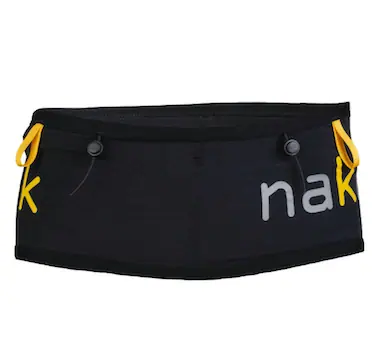 When you need additional space to carry smaller items, a waistbelt can be an excellent way to add another mini-base layer of warmth and storage without carrying a pack that could make your back sweaty. Despite being only a running waistbelt, the Naked Running Band will accommodate different-sized hydration soft flasks from a variety of brands. With two liters of storage, you can carry several smaller items like a headlamp, sunglasses, phone, and nutrition. It also includes silicone grip loops to help carry larger items like poles or a jacket.
When you need additional space to carry smaller items, a waistbelt can be an excellent way to add another mini-base layer of warmth and storage without carrying a pack that could make your back sweaty. Despite being only a running waistbelt, the Naked Running Band will accommodate different-sized hydration soft flasks from a variety of brands. With two liters of storage, you can carry several smaller items like a headlamp, sunglasses, phone, and nutrition. It also includes silicone grip loops to help carry larger items like poles or a jacket.
While you can fit a bunch of stuff in this belt, if you load it lightly, it fits nicely under a jacket. This is crucial for winter running as it helps keep food warm enough not to chip your teeth!
Naked’s products are incredibly light, and this running band is no exception. We haven’t found a better tube-style running belt than this one, so we named it our top choice in our Best Running Belts guide.
Shop the Naked Running BandBest Windbreaker Jacket: Patagonia Houdini Jacket ($109)
The Patagonia Houdini Jacket can provide extra warmth and keep the cold wind off for people living in cold and mostly dry climates. This is a jacket you’ll see on the iRunFar testing team on the start line of ultra on a chilly morning, high on a mountain ridge during the summer, and on snowy terrain over a warm baselayer during winter. Made of recycled ripstop nylon, the jacket is quite breathable and easy to unzip if you’re getting too hot during your run. It also has a PFAS-free DWR coating, meaning it’ll stand up to some light snow before it starts to get wet. The hood is big enough to fit over a thick winter hat, and you can cinch it tighter if the wind picks up.
This isn’t a jacket we’d take out if wet snow or rain were coming down, but it’s hard to beat for dry conditions or when it’s so cold that any snow that falls on you won’t melt. It weighs a scant 3.7 ounces and scrunches up to the size of your fist. This makes it easy to store in a running vest or belt, or you can just as easily tie it around your waist if you don’t need it anymore.
You can also find the Patagonia Houdini Jacket in our Best Windbreaker Jackets guide and our Best Running Jackets guide.
Shop the Women's Patagonia Houdini JacketShop the Men's Patagonia Houdini Jacket
Best Rain Jacket: Outdoor Research Helium Rain Jacket ($180)
 Despite being a fully waterproof jacket, we love the Outdoor Research Helium Rain Jacket for all conditions, including wind, snow, and cold. It’s lightweight and packable, and when unused, it will take up minimal space in your running pack or tied around your waist.
Despite being a fully waterproof jacket, we love the Outdoor Research Helium Rain Jacket for all conditions, including wind, snow, and cold. It’s lightweight and packable, and when unused, it will take up minimal space in your running pack or tied around your waist.
Other jacket elements include an adjustable hood, a drawcord hem, elastic cuffs, and a chest pocket that doubles as a stuff sack. It’s available in sizes from extra small to 4X in women’s and small to 3X in men’s, which is more size-inclusive than we see in many outdoor gear.
This jacket is made of a 30-denier ripstop nylon and is highly durable and protective for its weight. Since it’s waterproof, it is less breathable than a water-resistant jacket like the Patagonia Houdini Jacket above, so it can get a little warm if you’re wearing it when it’s not very cold out.
We chose the Outdoor Research Helium Rain Jacket as a top jacket in our Best Running Rain Jackets guide.
Shop the Women's Outdoor Research Helium Rain JacketShop the Men's Outdoor Research Helium Rain Jacket

iRunFar’s Meghan Hicks uses the Outdoor Research Helium Rain Ultralight Jacket as a warm layer during a late fall trip through Utah canyon country. Photo: iRunFar/Eszter Horanyi
Best Winter Running Jacket: Patagonia Nano-Air Hoody ($329)
 Several members of the iRunFar testing team have been using the Patagonia Nano-Air Hoody as their cold-weather jacket for a long time. Since it’s insulated, we recommend it for the coldest days: 20 degrees Fahrenheit down to -20 degrees. Two people noted that although it would be easy to get too warm while running in this jacket in any weather above these temperatures, the jacket has excellent wicking qualities that help prevent sweat from staying against your skin.
Several members of the iRunFar testing team have been using the Patagonia Nano-Air Hoody as their cold-weather jacket for a long time. Since it’s insulated, we recommend it for the coldest days: 20 degrees Fahrenheit down to -20 degrees. Two people noted that although it would be easy to get too warm while running in this jacket in any weather above these temperatures, the jacket has excellent wicking qualities that help prevent sweat from staying against your skin.
This jacket features a hood with a halo drawstring and elasticity to fit snugly around your head and face. The cuffs are soft and stretchy, which helps contain warmth around your hands and wrists. It’s thin enough to fit under a shell for additional warmth. We turned to this jacket for more than just running, using it for winter biking, hiking, and casual around-town wear.
It easily squishes into a backpack and fits into a larger hydration vest, like the Salomon Adv Skin 12 above. The durable water-repellent finish ensures you won’t get soaked immediately if it starts to sprinkle.
This jacket is ideal for higher-effort runs when the outside temperature is below freezing and for more measured efforts at slightly more moderate temperatures. It’s also a great all-around jacket for everyday use.
Shop the Women's Patagonia Nano-Air HoodyShop the Men's Patagonia Nano-Air Hoody
Best Hybrid Jacket for Winter Running: Patagonia Airshed Pro Pullover ($139)
 For shoulder-season conditions, the Patagonia Airshed Pro Pullover stands out as a hybrid layer that’s super versatile. It functions well in wind, snow, and a wide range of temperatures. It’s perfect for the classic all-seasons-in-one-day type of weather. This ultralight, thin “shacket” (shirt/jacket) combines fabrics and features perfectly suited to the weather and temperature swings that runners frequently encounter.
For shoulder-season conditions, the Patagonia Airshed Pro Pullover stands out as a hybrid layer that’s super versatile. It functions well in wind, snow, and a wide range of temperatures. It’s perfect for the classic all-seasons-in-one-day type of weather. This ultralight, thin “shacket” (shirt/jacket) combines fabrics and features perfectly suited to the weather and temperature swings that runners frequently encounter.
The jacket body consists of light, wind-blocking, and water-resistant polyester, while the sleeves and hood feature thin, stretchy, and breathable nylon. The front zipper reaches halfway down and opens two ways — zipping up from the bottom or down from the top. This makes it easy to dump heat if you get too warm. We found that the entire jacket breathes well enough, and overheating is rare. Like many of our favorite Patagonia layers, this one packs down small and stashes into its pocket if you need to stow it away.
This jacket’s sleeves are nice and long for chilly winter mornings, and its hood stays on decently well, especially if you’re wearing a hat underneath it. Gusty winds will knock it down. This jacket provides an outstanding balance between warmth, protection from the elements, breathability, and size.
Read more about this jacket in our in-depth Patagonia Airshed Pro Pullover review.
Shop the Women's Patagonia Airshed Pro PulloverShop the Men's Patagonia Airshed Pro Pullover
Best Base Layer Shirt for Winter Running: Smartwool Classic All-Season Merino Base Layer 1/4 Zip ($95)
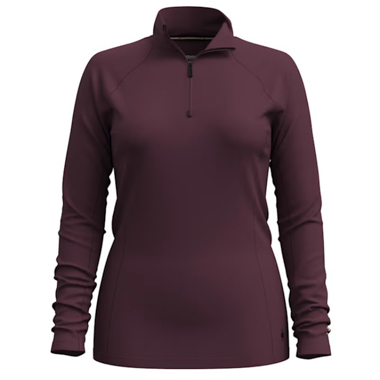 Smartwool has a variety of layers for pretty much any activity upon which you embark, and the Smartwool Classic All-Season Merino Base Layer 1/4 Zip is a versatile base layer that works alone when it’s not super chilly or underneath a more substantial layer when the weather warrants. It’s light enough that it’s a great option when you need that extra comfort immediately out the door, but know you’re likely to warm up and are going to want to stash a layer in a pack later on in your run. This base layer also works really well under a rain or wind jacket on late fall days when you have a protective layer on top to help combat rain or wind, but you don’t want to overheat.
Smartwool has a variety of layers for pretty much any activity upon which you embark, and the Smartwool Classic All-Season Merino Base Layer 1/4 Zip is a versatile base layer that works alone when it’s not super chilly or underneath a more substantial layer when the weather warrants. It’s light enough that it’s a great option when you need that extra comfort immediately out the door, but know you’re likely to warm up and are going to want to stash a layer in a pack later on in your run. This base layer also works really well under a rain or wind jacket on late fall days when you have a protective layer on top to help combat rain or wind, but you don’t want to overheat.
Wool base layers are ideal for various weather and temperatures because they pull moisture away from your body, retain warmth even when wet, are light on the skin, and dry quickly. The quarter-zip is the winning feature of this shirt because it’ll help you thermoregulate quickly — unzip, and you’ll promptly lose heat or zip it up for those frigid first miles of your run.
This shirt is also included in our Best Wool Running Apparel and Best Base Layers for Women guides.
Shop the Women's Smartwool Classic All-Season Merino Base Layer 1/4 ZipShop the Men's Smartwool Classic All-Season Merino Base Layer 1/4 Zip
Best Mid-Layer Shirt for Winter Running: Janji Rover Merino Hoodie
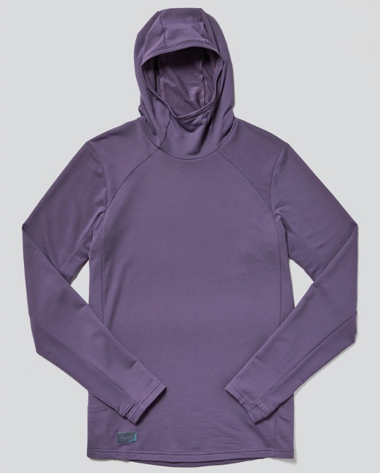 The key to running in the cold is proper layering, and the Janji Rover Merino Hoody is easy to put on over another shirt for extra warmth or to wear under a jacket. Made of a blend of merino wool, nylon, and spandex, this top is warm and stretchy, taking advantage of the benefits of each type of material used in it. Wool provides breathability and odor resistance, nylon makes it more durable, and the spandex offers a level of stretch that makes it easy to wear over other layers.
The key to running in the cold is proper layering, and the Janji Rover Merino Hoody is easy to put on over another shirt for extra warmth or to wear under a jacket. Made of a blend of merino wool, nylon, and spandex, this top is warm and stretchy, taking advantage of the benefits of each type of material used in it. Wool provides breathability and odor resistance, nylon makes it more durable, and the spandex offers a level of stretch that makes it easy to wear over other layers.
The fabric effectively wicks moisture, and we found ourselves reaching for this top as an insulating layer over a base layer and as a standalone layer for less cold days. However, we found that the material picked up a bit of stink if we wore it next to our skin.
The scuba-style hood fits close against the head and stays in place while running, even if the wind picks up. It has a ponytail hole for those who like to use them. We generally think tighter hoods look dorky, but we can’t argue against their functionality.
We appreciated that the sleeves of this top were long and had thumbholes to keep them down. While the extra material over the back of the hands doesn’t substitute for a pair of gloves, it’s enough to provide an extra bit of warmth if it ends up being chillier than you expected. There’s a small pocket in the hem of the shirt, but it’s not really useful for much beyond a credit card or a car key.
Shop the Women's Janji Rover Merino HoodyShop the Men's Janji Rover Merino Hoody
Best Winter Running Tights: Patagonia Endless Run Tights ($119)
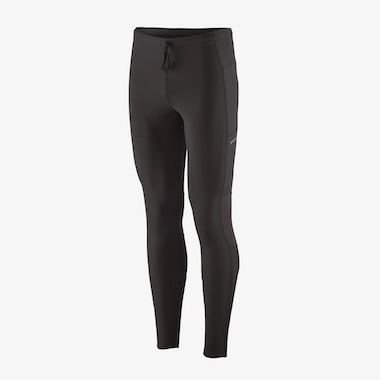 While the Patagonia Endless Run Tights have a lot going for them, including being breathable and moisture-wicking, we most appreciated their mid-rise fit, which moves well and doesn’t shift while you’re running.
While the Patagonia Endless Run Tights have a lot going for them, including being breathable and moisture-wicking, we most appreciated their mid-rise fit, which moves well and doesn’t shift while you’re running.
These tights are sufficient for cool to cold days. They employ material designed to keep you warm and dry, with mesh panels behind the knees for breathability. The tights have two side pockets for a phone, snacks, or other small essentials and an elastic waistband with a drawcord. Patagonia sized the women’s tights to fit waist sizes ranging from 24.5 inches to 41.5 inches, and the men’s version will fit waist sizes ranging from 28 inches to 45 inches. These pants are Fair Trade Certified, and Patagonia is known for its wide-ranging environmental activism, so you can feel good about owning these tights.
Shop the Women's Patagonia Endless Run TightsShop the Men's Patagonia Endless Run Tights
Best Insulated Winter Running Tights: Gorewear R3 Thermo Tights ($120)
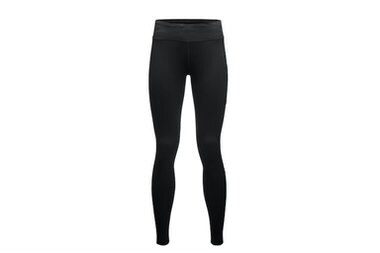 Freezing weather no longer has to be an excuse to run on a treadmill or skip a run altogether. When it’s freezing and/or stormy, the iRunFar team turns to the Gorewear R3 Thermo Tights to get out the door for a run and stay protected and comfortable while we’re out there.
Freezing weather no longer has to be an excuse to run on a treadmill or skip a run altogether. When it’s freezing and/or stormy, the iRunFar team turns to the Gorewear R3 Thermo Tights to get out the door for a run and stay protected and comfortable while we’re out there.
These tights are the warmest in the Gorewear running collection, with a brushed fleece lining for warmth and comfort. They are designed for cross-country skiing and running and move well with your body. Panels of breathable polyelastane allow for natural venting so that these tights stay dry when you sweat.
These tights zip at the lower leg for easier donning and doffing. There is an easy-access side pocket on the thigh and a small zippered rear pocket for keys and other small valuables. The sizing is slightly more limited than the Patagonia tights above. The women’s sizes fit waists measuring from 23.5 inches to 32.25 inches, and the men’s tights fit waist sizes from 27.5 to 40.25 inches.
Shop the Women's Gorewear R3 Thermo Tights Shop the Men's Gorewear R3 Thermo Tights
Best Headband for Cold Weather Running: Buff Dryflx Headband ($17)
 Buff neck gaiters are so widely popular among runners and outdoor enthusiasts for their year-round versatility that all neck gaiters are commonly referred to as “Buffs” in the same way tissues are often called “Kleenex.” While the standard Buff neck gaiter may not be your top choice for the coldest, windiest, and snowiest of days, the Buff Dryflx Headband is on the advanced end of the brand’s offerings, touting an ultralight, breathable, and quick-drying fabric.
Buff neck gaiters are so widely popular among runners and outdoor enthusiasts for their year-round versatility that all neck gaiters are commonly referred to as “Buffs” in the same way tissues are often called “Kleenex.” While the standard Buff neck gaiter may not be your top choice for the coldest, windiest, and snowiest of days, the Buff Dryflx Headband is on the advanced end of the brand’s offerings, touting an ultralight, breathable, and quick-drying fabric.
We loved the 360-degree reflectivity of this headband, as many winter runs happen in the dark, not just in the cold. Any additional visibility increases your safety, and this headband lights up when hit by a car’s headlights. Since this headband is pretty light, it’ll compress to a tiny ball to be stored anywhere when you no longer need it on a run.
Shop the Buff Dryflx HeadbandBest Winter Running Beanie: Sauce Swift Toque ($32)
 When the weather is such that a headband won’t suffice as a head-covering, we reach for the Sauce Swift Toque. This lightweight beanie is designed for high-output activities in cold weather and is ideal for running in the winter. A former Canadian cross-country ski racer launched the Bozeman, Montana-based brand (hence the word toque and not beanie in the product’s name). The performance fabric is comfortable and breathable, and it’s incredibly cozy as well.
When the weather is such that a headband won’t suffice as a head-covering, we reach for the Sauce Swift Toque. This lightweight beanie is designed for high-output activities in cold weather and is ideal for running in the winter. A former Canadian cross-country ski racer launched the Bozeman, Montana-based brand (hence the word toque and not beanie in the product’s name). The performance fabric is comfortable and breathable, and it’s incredibly cozy as well.
The fabric is lightweight and stretchy, providing good coverage over the ears, and we found it to be an incredibly versatile hat. It’s also machine washable. Sauce offers many color and print options, from a muted solid black to vibrant patterns and mountain prints. Additionally, you can add a pom or tassel to the top at no additional cost — how fun is that?
We also feature this hat in our Best Running Hats guide, where we named this the best hat for winter running.
Shop the Sauce Swift ToqueBest Brimmed Hat for Winter Running: Buff Pack Merino Fleece Cap ($42)
 Fleece and merino wool pair together perfectly in the Buff Pack Merino Fleece Cap to help keep you warm on cold days. This cap has an adjustable fit and a hidden ponytail hole to ensure a secure fit and maximum coverage in winter’s nastiest weather. Our team loved the benefits of the brim, including protection from the sun and moisture of the liquid and frozen varieties.
Fleece and merino wool pair together perfectly in the Buff Pack Merino Fleece Cap to help keep you warm on cold days. This cap has an adjustable fit and a hidden ponytail hole to ensure a secure fit and maximum coverage in winter’s nastiest weather. Our team loved the benefits of the brim, including protection from the sun and moisture of the liquid and frozen varieties.
This is a unique product, and the first of its kind that we’ve used. The combination of brimmed hat, winter hat, and headband makes this the ideal head topper for winter days that are sunny and could have light snow as well. It’ll keep your head warm and dry while also keeping the light and snow showers out of your eyes.
Shop the Buff Pack Merino Wool Fleece CapBest Gloves for Winter Running: Ultimate Direction Ultra Flip Glove ($40)
 The glove-to-mitten combination is no longer a unique design, but the Ultimate Direction Ultra Flip Glove has been a favorite of iRunFar’s managing editor, Meghan Hicks, for several years. Gear editor Eszter Horanyi chose them on her Nolan’s 14 Unsupported FKT run, and they continue to be the flip gloves we trust in a variety of conditions. There’s a reason we selected these gloves in our Best Running Gloves guide and reviewed them thoroughly in our Ultimate Direction Apparel Review – they’re really good gloves!
The glove-to-mitten combination is no longer a unique design, but the Ultimate Direction Ultra Flip Glove has been a favorite of iRunFar’s managing editor, Meghan Hicks, for several years. Gear editor Eszter Horanyi chose them on her Nolan’s 14 Unsupported FKT run, and they continue to be the flip gloves we trust in a variety of conditions. There’s a reason we selected these gloves in our Best Running Gloves guide and reviewed them thoroughly in our Ultimate Direction Apparel Review – they’re really good gloves!
The convertible glove is an excellent design for variable temperatures. We use them when we know the day will start cold and get warm, or when things start cold and dry but there’s a chance of precipitation in the forecast. They’re also great for those who have circulation issues like Raynaud’s syndrome (when you don’t get enough circulation to your fingers) and need extra warmth without wanting to sacrifice the mobility of gloves. They’re also light and packable enough to toss them in your pack as a just-in-case item and forget about them.
The inner glove is grid fleece, and the over-mitt is a silicone-coated waterproof Cordura ripstop. The mitten part of the glove folds up into the wrist section, which is a nice touch as this keeps the unused mitten portion from flopping about or getting in the way. While this glove won’t keep your hands dry and warm in the nastiest of conditions, they’re great for nearly everything else.
Shop the Ultimate Direction Ultra Flip GloveBest Gloves for Very Cold Conditions: Trailheads Convertible Zip Mitts ($52)
 We recently added the Trailheads Convertible Zip Mitts to our Best Running Gloves guide after loving their Primaloft recycled polyester insulation, extended cuffs, and wrist straps that seal in warmth to keep our fingers and hands warm all last winter.
We recently added the Trailheads Convertible Zip Mitts to our Best Running Gloves guide after loving their Primaloft recycled polyester insulation, extended cuffs, and wrist straps that seal in warmth to keep our fingers and hands warm all last winter.
These mitts are great for super-cold weather, which we consider temperatures dropping below 20 degrees Fahrenheit. So far, we’ve tested them in temperatures down to -15 degrees Fahrenheit, and they are still plenty warm for our team.
Mittens are the ultimate choice for keeping hands warm when temperatures really drop, and we love how these mitts make no compromises when keeping our digits warm in the depths of winter. At the same time, if we need to dig a car key out of our pocket, turn our headlamp off, or snap a photo of an epic sunrise, the mitts have a zipper that frees our hands for a brief moment. The only drawback of these supremely warm mitts is that they’re rather heavy and not easily packable, so they’re not the best choice if you anticipate needing to shed layers when the day warms.
But if you’re committed to running outside when temperatures get frigid, you can trust these gloves to keep your hands warm and dry.
Shop the Women's Trailheads Convertible Zip MittsShop the Men's Trailheads Convertible Zip Mitts
Best Sports Bra for Cold Weather: Smartwool Women’s Intraknit Racerback Bra ($65)
When you want an extra layer of warmth and protection along with a good level of support, the Smartwool Women’s Intraknit Racerback Bra is an excellent option for cold running conditions. This sports bra is thicker than most, and our first impression was that it was heavy. But after wearing it in a wide range of temperatures, including dropping well below freezing, we found that it’s incredibly warm and almost doubles as an additional layer for keeping the core warm. The merino wool is soft against the skin, and the material stretches enough that getting the bra on and off doesn’t turn into a wrestling match that threatens to dislocate shoulders.
Smartwool has added Tencel Lyocell to the merino to decrease the drying time and provide more durability. We found that the material was thick enough that when it got wet, it took a lot of time to dry. But since it’s wool, it still provided warmth when damp.
While Smartwool advertises this bra for low-impact activities, we used it regularly for running without issue and wore it multiple days in a row without experiencing any stretching or loss of support. It includes two extra support cups, but the bra provides plenty of support for smaller-chested people without them. While it may feel too thick for some people, we appreciated the warmth and support provided.
A back pocket provides enough space for a few small items, and we didn’t have any issues with things bouncing around or being uncomfortable. The ribbed bottom band never felt too tight, and the racerback style didn’t rub or chafe.
Shop the Smartwool Women's Intraknit Racerback Sports BraBest Wool Socks for Cold Weather: Smartwool Run Cold Weather Targeted Cushion Crew Socks ($24)
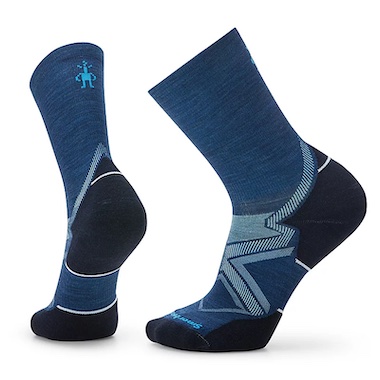 Designed specifically for running, the Smartwool Run Cold Weather Targeted Cushion Crew Socks feature merino wool blended with nylon and elastane. They have additional mesh zones to help keep your feet both warm and dry in colder weather.
Designed specifically for running, the Smartwool Run Cold Weather Targeted Cushion Crew Socks feature merino wool blended with nylon and elastane. They have additional mesh zones to help keep your feet both warm and dry in colder weather.
The mid-crew style is the perfect length for running in winter — it keeps your ankles covered and protected in a cold breeze, snow, and/or slush. Targeted cushions at the toe and heel help keep those areas blister-free, especially when the feet get wet. The toe is virtually seamless, so you don’t have to worry about blisters in that area, either.
Even though our team has given this sock the Goldilocks description of “not too thick, but not too thin,” it is a proper winter sock. We found it to be a little thicker than the average running sock, so you might not want to pair it with tighter shoes.
Shop the Women's Smartwool Run Cold Weather Targeted Cushion Crew SocksShop the Men's Smartwool Run Cold Weather Targeted Cushion Crew Socks
Best Headlamp for Winter Running: Petzl Iko Core ($105)
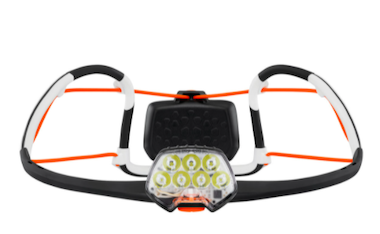 Keeping a headlamp on when wearing a warm hat can be challenging, and we particularly like the Petzl Iko Core headlamp for winter running because of its unique structure. It easily fits over a hat, Buff, or even a helmet and is held in place with a silicone band rather than the traditional stretchy headband common to most headlamps. Because it has a more solid skeleton, it also helps reduce pressure headaches and sore spots that can occur with other headlamps.
Keeping a headlamp on when wearing a warm hat can be challenging, and we particularly like the Petzl Iko Core headlamp for winter running because of its unique structure. It easily fits over a hat, Buff, or even a helmet and is held in place with a silicone band rather than the traditional stretchy headband common to most headlamps. Because it has a more solid skeleton, it also helps reduce pressure headaches and sore spots that can occur with other headlamps.
With a maximum illumination of 500 lumens, which can reach 100 meters, it produces plenty of light for nearly all running applications. The minimalist design is super lightweight. It is rechargeable but is also compatible with three AAA batteries. If you’re in a pinch, it will run for 100 hours on the lowest six-lumen setting or 2.5 hours on the highest 500-lumen setting.
If you’re considering your options for lighting during the dark winter months, you might want to read our Best Running Headlamps guide, where we rate this as the best headlamp for trail running.
Shop the Petzl Iko CoreBest Sunglasses for Winter Running: Smith Motive ($175-$185)
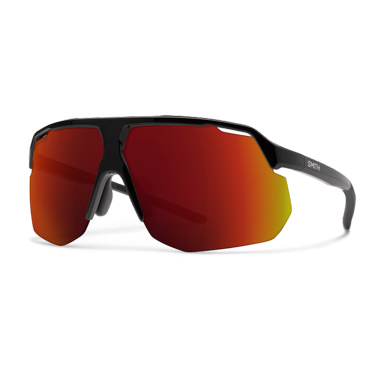 When it comes to wintertime versatility, it’s hard to beat the Smith Motive sunglasses. Our primary tester used them for everything from running to ski touring and was impressed by how they didn’t fog up, even in difficult weather conditions. These large-lens sunglasses fit medium-sized faces well and provide ample coverage. The slight wrap-around design increases protection from side winds. They’re incredibly light at 29 grams and sit far away from the face to allow for enough airflow to minimize the chance of fogging.
When it comes to wintertime versatility, it’s hard to beat the Smith Motive sunglasses. Our primary tester used them for everything from running to ski touring and was impressed by how they didn’t fog up, even in difficult weather conditions. These large-lens sunglasses fit medium-sized faces well and provide ample coverage. The slight wrap-around design increases protection from side winds. They’re incredibly light at 29 grams and sit far away from the face to allow for enough airflow to minimize the chance of fogging.
The Smith Motive come with two sets of interchangeable lenses, and you can choose the specific lens combo that suits the types of conditions you run in. The optics of these glasses are outstanding, and they are the main reason for the high price tag. We believe that for people who value optics, and run through the many lighting conditions that winter can offer up, they are worth the investment. It feels like we can see more details when looking through these glasses than we can without them on.
You can read more about the details of these sunglasses in our in-depth Smith Motive review.
Shop the Smith Motive sunglasses
iRunFar’s Alli Miles tests the Smith Motive sunglasses in low-light conditions. Photo: iRunFar/Eszter Horanyi
Buyer’s Guide: How To Choose the Right Cold Weather Running Gear
The Importance of Layering When Running in the Cold
When running in the cold, the most important part of staying safe and comfortable is appropriately managing your internal temperature under changing weather conditions and exertion levels. Staying warm while standing still in cold weather requires much more clothing than walking, and running requires even fewer layers. The best cold-weather running gear can help you maintain the correct internal temperature.
The body is only about 25% efficient when it comes to using energy for muscle contractions, meaning that for every unit of energy used to contract a muscle, three units of energy release as heat. The faster we run, the more energy we use, and the more heat gets created, making us warmer. Having layers, like the Janji Rover Merino Hoody midlayer, to take off during a run can help maintain a steady body temperature as you warm up. Conversely, if you’ve done some strenuous efforts and are doing a cool-down jog, you’ll want to have extra layers to put on to compensate for your body generating less heat and cooling off.
Carrying a lightweight shell, like the Patagonia Houdini Jacket, can make adjusting your temperature while you’re running easy and quick.
Layers are also essential to protect against changing weather conditions. Temperatures can drop drastically during the winter and become dangerous if you don’t have extra layers. An additional layer, like the Patagonia Airshed Pro Pullover, is an excellent insurance policy against rapidly deteriorating weather conditions.
Safety Considerations When Choosing Cold Weather Running Gear
Cold-weather running can be dangerous without the proper clothing and equipment. Hypothermia and frostbite are very real issues that you should consider when gearing up to head outside in the cold, and there are some basics to running in the cold that all trail runners should be aware of.
When we expose skin to freezing temperatures for too long, frostbite can occur and cause permanent damage. The speed at which frostbite happens depends on the ambient temperature, wind chill, and body parts exposed to the air.
Frostbite is most common on fingers, toes, the nose, ears, and other parts of the face. It occurs more quickly in areas of the body without much blood flow to keep the skin warm. To keep your fingers protected, it’s important to have a pair of gloves, like the Ultimate Direction Ultra Flip Glove. You can also use the Buff Dryflx Headband to protect your ears while still letting the top of your head release excess heat.
You can identify frostbite by skin that has turned cold and red before turning numb, hard, and pale. Minor cases of frostbite are often referred to as frostnip and can be treated by gently rewarming the skin. You can learn more about preventing and treating frostbite on the trail.
While frostbite can happen quickly, hypothermia generally has a slower onset and can be much more dangerous. Hypothermia occurs when the body temperature drops below 95 degrees Fahrenheit (35 degrees Celsius). Symptoms of mild hypothermia include shivering, dizziness, hunger, nausea, rapid breathing, increased heart rate, issues talking, and confusion. As it worsens, it can result in increased shivering followed by a lack of shivering, lack of coordination, slurred speech, poor decision-making, drowsiness, weak pulse, and slow, shallow breathing. Ultimately, hypothermia can result in loss of consciousness and death.
Having the best cold-weather running gear to keep you warm and dry in the cold is critical. It’s also important to make good decisions when running in the cold. If you feel a part of your body going numb, you need to take action immediately, whether adding an extra layer, such as the Janji Rover Merino Hoodie, to warm your core or just heading home. And while shivering is an amazing biological adaptation for staying warm, it’s a sign that you need to attend to your body’s temperature. Running with a warm jacket like the Patagonia Nano-Air Hoody can help prevent a dangerous situation.
Choosing Waterproof Versus Normal Running Shoes in Cold Weather
There are two primary schools of thought regarding using waterproof shoes in the winter. When you’re running through puddles or mud, they can keep water out and keep your socks and feet dry, which will help keep them warmer. Waterproof shoes are also inherently warmer than non-waterproof ones because of the material of the uppers. But waterproof shoes are also less breathable than normal shoes, so when your feet sweat or water gets into them from around the ankles, there’s no place for that moisture to go, leading to feet that are damp from sweat
Feet get cold when the insulating layer around them, namely your socks, gets wet, and it doesn’t matter if they get wet from the rain or sweat. One technique winter athletes use to keep their feet warm is to wear a vapor barrier sock underneath their socks. Vapor barrier socks trap sweat next to the foot and keep it from getting the insulating sock wet. While this might sound counterintuitive, vapor barriers, which can be as simple as a plastic bag on your feet under your socks, are a great way to maximize the effectiveness of waterproof shoes, keeping your insulating sock dry from the inside and the outside.
Whether you choose waterproof or regular running shoes for your cold-weather outings, the Salomon Speedcross 6 and the Salomon Speedcross 6 Gore-Tex are great options for winter conditions.
Choosing the Right Jacket for Cold Weather: Waterproof, Insulated, or Non-Insulated
The key to staying safe and comfortable during winter runs is maintaining a steady body temperature and staying dry, and different conditions call for different types of jackets. Each jacket style has inherent benefits and drawbacks and can excel under specific circumstances. When it comes to a jacket that can do it all, we found that the Patagonia Airshed Pro Pullover was an excellent option for many weather conditions.
Fully waterproof jackets will keep you dry from any precipitation and block the wind, but they often aren’t very breathable and can leave you soaked from your sweat, especially during intense efforts. If you’re considering your options for a waterproof jacket for running in cold weather, look at our Best Running Rain Jackets guide. Our testers settled on the Outdoor Research Helium Rain Jacket as the best waterproof option for cold-weather running.
Insulated jackets come in an array of materials, and some are waterproof as well. A non-waterproof synthetic jacket is an excellent option for staying warm under dry conditions. Synthetic insulation will remain warm even when wet, so while it’s still a good idea to try not to sweat through it, it can handle a little moisture. Our team tested an array of jackets for this guide, and when it came to choosing our favorite insulated jacket, the Patagonia Nano-Air Hoody came out on top. You can explore other options in our Best Insulated Jackets for Running guide.
We also appreciated the light weight of the Patagonia Houdini Jacket and used it as a windbreaker shell for runs where we were confident there wouldn’t be any precipitation.

The Patagonia Houdini Jacket is idea for cold dry runs when you don’t have to worry about precipitation. Photo: iRunFar/Eszter Horanyi
Choosing Gear for Staying Dry While Running
Sweat and condensation are enemy number one when running in the cold and can quickly take you from comfortable to hypothermic. The goal of the best cold-weather running gear is to keep you both warm and dry. There are many ways to maintain an even body temperature, including moderating your effort, adding or removing layers, or increasing ventilation. One thing is sure: if you start to sweat, you need to do something about it quickly. The same goes for getting cold. A little prevention can go a long way toward avoiding a dangerous situation.
Clothing that breathes well is important to stay dry. Synthetic materials and wool are great options for wicking moisture off your skin and helping it evaporate into the air. A base layer, like the Smartwool Classic All-Season Merino Base Layer 1/4 Zip, is a good place to start when putting together a winter running kit. Wearing layers also makes adjusting your insulation on different body parts easy. Removing a hat, like the Sauce Swift Toque which can easily be carried in a pocket, or unzipping a jacket can let your body offload heat and keep it from sweating excessively. Several tops designed for winter use, including the Patagonia Airshed Pro Pullover, have front or underarm zips to help a warm body vent.
Wearing a pack when running in the cold can keep sweat from evaporating from your back. Using a waistbelt like the Naked Running Band to carry keys and snacks can keep the clothing around your core wicking moisture efficiently and preventing a sweaty back.
Why Wool Is a Good Choice for Cold-Weather Running Gear
Merino wool is a go-to material for many people who exercise in cold weather. This lightweight fiber is an insulating and breathable product of merino sheep. Its properties allow it to trap air and provide insulation while transporting moisture from your skin before it can turn into droplets and dampen everything. Modern merino clothing is soft and comfortable throughout a range of temperatures and has the bonus of not getting stinky after a single run. We loved the Smartwool Classic All-Season Merino Base Layer 1/4 Zip as a base layer we could add additional layers to, depending on the temperature. It comes in various weights and can be used as a base layer, mid-layer, or both. We also loved the Buff Pack Merino Fleece Cap for our cold weather runs. Most modern wool clothing blends merino wool with something like Tencel, nylon, or polyester to make it a more durable material and decrease drying time.
You can read our Best of Wool Running Apparel guide to learn more about the unique properties of wool and some of our favorite products made of the material.

Just because the snow flies doesn’t mean you have to move your training indoors. Photo: Photo: iRunFar/Alli Miles
Choosing the Right Cold Weather Running Gloves
A lot of runners struggle with keeping their hands warm. Fingers already receive relatively light blood circulation compared to other parts of your body, and when your body starts to get cold and needs to conserve heat, it’ll reduce blood flow to your extremities, including your fingers. This helps the body keep warm blood in the core, protecting vital organs. For people suffering from Raynaud’s syndrome, their bodies overreact to cold and shut off most blood circulation to the fingers, turning them numb and white. Cold hands can occur at a relatively warm temperature for those suffering from Raynaud’s. You can read more about managing Raynaud’s syndrome and keeping extremities warm.
Whether you suffer from Raynaud’s or not, having the right gloves can make a big difference in comfort.
Normal five-fingered gloves come in various weights and can provide anything from a little extra warmth to ward off the chill to protection against truly arctic conditions. When temperatures get extremely cold, mittens keep your fingers much warmer than regular gloves, and we turned to the Trailheads Convertible Zip Mitts for deep winter runs. As with all gear for cold weather running, you want to ensure you’re not sweating too much and getting the insulation wet from the inside.
Convertible gloves, like the Ultimate Direction Ultra Flip Glove, are an excellent option for managing the warmth of your hands. They consist of a lighter pair of five-fingered gloves with a mitten cover, which can provide a lot of extra protection when it starts to get cold. When temperatures rise again or your hands get sweaty, you can pull the mitten shell off to provide more ventilation and temperature control. In our Best Running Gloves guide, you can check out some of our other favorite gloves for different conditions.
Choosing the Right Hat for Cold Weather Running
While the idea that we lose half of our body heat through our head is a myth, a covered head can make a big difference in staying warm. Hats are also an excellent option for regulating body temperature since they are so easy to take off if you start to get hot, and they stash easily in a pack or a fist until they are needed again. Our team loved the Sauce Swift Toque for running in cold weather. Not only did it provide plenty of warmth, but it was easy to store.
Winter hats come in many styles, but the key is to choose one that has insulation for your noggin and blocks the wind. Some hats, like the Buff Pack Merino Fleece Cap, come with a brim and extra material to cover your ears since they are often one of the first parts of a body to get cold.
Why Trust Us
We at iRunFar don’t hesitate to run and fastpack in cold weather. Many of our testing team members live in locations where winter temperatures can get frigidly cold, including Idaho, Colorado, Minnesota, and Montana. We’ve spent decades experimenting with different cold-weather running setups and developed systems that keep us warm and dry in the worst conditions. Our testing team goes out in various temperatures, ranging from just a bit chilly to downright arctic. We’ve tested gear options extensively so that we can provide the best recommendations for running in a variety of cold weather conditions.
Frequently Asked Questions About Cold Weather Running Gear and Running in Cold Weather
When is it too cold to run outside? Is it safe to run in cold weather?
While runners like to think of themselves as tough and ready to run in any conditions, there are temperatures when it’s simply a better idea to move a workout inside or just sit in front of a fire with a cup of hot cocoa instead. Even the best cold-weather running gear can’t protect against everything.
Running when it’s well below freezing out can damage your lungs, especially if you’re working hard. If it’s below 17 degrees Fahrenheit, you’ll want to avoid breathing hard or gasping during your workout. It’s important to listen to your body during cold-weather runs, and if you feel your lungs getting irritated by the cold, you’ll want to stop and get warm as soon as possible.
Cold temperatures can also cause frostbite, especially on bits of skin exposed to the elements. The speed at which frostbite occurs depends on the ambient temperature and wind chill. Keeping facial skin covered with some warm material can help reduce the chance of frostnip or frostbite and allow you to stay out in colder temperatures. Having a good pair of gloves like the Trailheads Convertible Zip Mitts can protect your fingers, one of the more common places to experience frostbite.
You’ll also need to pay extra attention to keeping your joints warm when running in extreme cold. A good pair of insulated tights, like the Gorewear R3 Thermo Tights, can protect your knees from the cold and help warm your ankles and feet during the coldest of runs.
Read our science article on cold-weather running to learn more about staying safe while running in the cold.

Testing the Outdoor Research Helium Rain Jacket in Wyoming’s Wind River range. Photo: iRunFar/Eszter Horanyi
What’s the best jacket for running in cold weather?
Choosing the right jacket for running is highly dependent on the conditions. In most situations, you’ll want a jacket that can block the wind and provide insulation to trap heat next to your body, helping you maintain a steady core temperature. You also want a jacket to be as breathable as possible to keep your base and mid-layers from getting soaked in sweat.
If you think that sounds like a stretch for any single jacket’s functionality, you’re not wrong, and most runners will end up with an array of jackets to suit different conditions. A jacket with a full zipper, vents, and pit zips can be workable in various temperatures by allowing you to increase airflow on your body and regulate your core temperature during a run. Our team found the Patagonia Nano-Air Hoody to be a highly versatile jacket that we could use in various cold-weather conditions.
Do I need a waterproof or Gore-Tex running jacket to run in the winter?
A good waterproof jacket is important if you live where most of the winter precipitation comes down as rain. We chose the Outdoor Research Helium Rain Jacket as our favorite waterproof jacket and were able to adjust the layers underneath it to keep our core at the right temperature. If you run in snow frequently, you’ll have to worry less about incoming precipitation getting you wet from the outside since if it’s cold enough, the falling snow won’t melt on you. You might be better off with breathable layers in snowy climates than a full waterproof jacket. Gore-Tex jackets are an excellent waterproof and breathable option, but they cost significantly more than other similar jackets.
What are the best shoes for running on snow and ice?
Finding the right shoes for running on snow and ice can keep your feet warm and help save you from a nasty spill on a slick surface. To help you find a purchase on snow, you’ll want a shoe with good lugs that can grip the soft surface. Our testers found the Hoka Speedgoat 6 to handle better on packed snow than the other shoes we tested. Sticky rubber can also improve traction on slippery surfaces.
When it comes to pure ice, especially when it’s off-camber, most shoes cannot do much. You’ll want to start considering using traction devices, like our favorite, the Black Diamond Distance Spike. Having a set of traction devices can allow you to use whatever shoes you want on your winter run but with extra grip. You can read a full review of iRunFar’s favorite traction devices to help you choose the right ones for your running conditions.
One thing to consider when running in the cold is the type of socks you will wear and if it’s worth getting a shoe that’s a half-size or a full-size bigger. Generally, cold feet aren’t a direct result of freezing temperatures but of poor circulation. Trying to shove your foot with a thick sock into the same shoe you use for summer running can reduce circulation to your feet and make them colder than if you just went with regular socks.

To determine their grip, the iRunFar team tested traction devices on various snow slopes. Photo: iRunFar/Eszter Horanyi
Do I need to wear waterproof or Gore-Tex running shoes in the winter?
Waterproof and Gore-Tex running shoes are great at keeping moisture out if you’re not going through water or snow higher than the top of the shoe. They are also warmer than regular running shoes. The downside of fully waterproof shoes is that they are less breathable than normal shoes, which can result in damp socks. Gore-Tex, which is waterproof and highly breathable, alleviates some of the issues with sweaty socks by allowing moisture to escape. Our testers turned to the Hoka Speedgoat 6 for most of their winter running. This shoe also comes in a waterproof Gore-Tex version currently being tested by the iRunFar team.
Should I wear traction devices to run in the winter?
If you’re consistently running on snow and ice, you’ll want a pair of traction devices handy for safety and running comfort. Traction devices can be helpful both on softer-packed snow and on ice. Even on softer surfaces, they can make running easier by taking the fear of slipping out of the equation. They’re functional on decently steep grades, but once you start getting on steep, hard snow, you’ll want to consider upgrading to proper mountaineering crampons and boots.
Our testers chose the Black Diamond Distance Spike as the best off-road traction device due to its grip and ease of use. However, they can be a bit much for mixed-surface running, so our testers turned to the Kahtoola EXOspikes for runs that went from ice to snow to dirt to pavement and back again.
Most traction devices are lightweight and can be stowed away in a pack if you go on a mixed-surface run. They can help you cross a stretch of ice or hardpacked snow that will send anyone in regular shoes back to the trailhead, and they are a worthy addition to any winter running pack.
I am always cold when I run. How do I stay warm and dry while running in cold weather?
It might seem that the way to stay warm is to layer on as much clothing as possible, but there’s more to it than that. To keep warm, you have to stay dry. Once your insulating layers get wet in cold weather, either from precipitation or sweat, the clock is ticking until you need to get out of your wet clothes to keep hypothermia from developing.
Layers, breathable clothes, and effort regulation are the main pillars for successful winter running. You want to constantly adjust your layers and effort level to run the fine line between staying warm enough to be comfortable and starting to sweat with your current set of clothing. Having layers to remove and put on can allow you to adjust your effort without sweating or getting too cold. Choosing breathable clothing that wicks moisture from your skin and helps it evaporate can keep sweat from soaking everything you’re wearing. The Janji Rover Merino Hoodie is a great mid-layer option for those who tend to get cold and need extra warmth on cold days.
Keeping extremities warm in the winter can be challenging, and fingers are often the hardest body part to stay comfortable. Having the right gloves for the temperature can make a big difference. Our Best Running Gloves guide includes various options, including one of our favorite pairs, the Ultimate Direction Ultra Flip Glove.
I am always hot when I run. How do I stay cool and dry while running in cold weather?
Some people simply run hotter than others, and you’ll see these people running in shorts, a singlet, and a light pair of gloves while the rest of humanity is walking around in down jackets and heavy winter hats. Layers are the key to keeping your body at the right temperature, and you’ll want to be diligent about removing them as you get warm so that you don’t sweat through your insulation. Once you’ve gotten a layer wet, you’ve pretty much made it useless if you get cold.
Beginning with a wicking base layer, like the Smartwool Classic All-Season Merino Base Layer 1/4 Zip, is a good start to maintaining a comfortable core temperature. You can start a run with more layers and end up stripping down to a single one as the run continues. If you need a jacket to protect against precipitation, you’ll want to consider a breathable Gore-Tex jacket with lots of vents to help release heat and moisture.

A light shell can help a body retain warmth and be easy to carry if temperatures warm up. Photo: iRunFar/Eszter Horanyi
How do I layer my clothes for running in cold weather?
When considering using layers for running, there are three broad categories: base layers, mid layers, and outer shells.
Base layers, like the Smartwool Classic All-Season Merino Base Layer 1/4 Zip, go at the bottom of the pile of the clothing you’re wearing, right next to your skin. They should be breathable and wicking so that they can move moisture away from your skin, allowing it to evaporate instead of staying wet. Most base layers are relatively lightweight and made of merino wool or synthetic material.
Midlayers provide insulation during cold weather runs and can include a variety of materials. These layers are where you can really dial in comfort. A thin wool layer can suffice as a second layer on top of your base layer if it’s relatively warm. Adding a fleece or thicker synthetic layer can add more warmth. Our testers love the Janji Rover Merino Hoodie as a mid-layer. You’ll want to ensure you’re not sweating through this insulation layer when running in the cold.
An outer shell, or jacket, is an important layer to protect you from the elements. It can block the wind, keep precipitation from getting your other layers wet, and trap warm air against your body to add extra warmth. A non-breathable outer shell can lead to excess sweating, so you’ll need to be careful with your effort regulation when wearing one. We found the Patagonia Airshed Pro Pullover to be a great hybrid shell option that protects from wind and snow in many different temperatures.

Maggie Guterl and Easy the Doggo showing off layering systems during a spring fastpacking trip. Photo: iRunFar/Eszter Horanyi
Should I wear wool when I run in cold weather?
Wool is an excellent option for running in cold weather because of its ability to insulate and wick moisture away from your body. The unique fibers grown by merino sheep, mainly in Australia and New Zealand, allow sweat to evaporate from your body before it turns into liquid drops. Unlike cotton or other materials that hold onto liquid, wool can keep you much dryer and help you avoid that clammy feeling associated with other materials. Wool also stays warm, even when wet. While wool shirts and socks, like the Smartwool Run Cold Weather Targeted Cushion Crew Socks, are the best-known garments from this material, wool tights, hats, underwear, shorts, bras, like the Smartwool Women’s Intraknit Racerback Bra, all make for comfortable and functional pieces of running clothing.
Read more about merino fiber and our top choices for clothing pieces in our Best Wool Running Apparel guide.
How do I choose the best gloves for running in cold weather?
There are endless choices for running gloves, and personal preference plays largely into what will work for you. The hands are often the hardest part of the body to keep warm while running, mainly because of lower blood circulation levels, and the right gloves need to fit correctly. Gloves that are too tight can reduce blood circulation even more and make cold hands even colder.
Good gloves for running will wick moisture, provide insulation, and be dexterous enough to let you perform basic tasks. For frigid temperatures, mittens may be the best option. Not separating the fingers into different compartments can keep your hands much warmer. Convertible gloves, which can switch between glove and mitten modes, can provide both the dexterity of gloves and the added protection and warmth of mittens. When it came to running on the coldest of mornings, our testers turned to the Trailheads Convertible Zip Mitts for their warmth and dexterity.
What are the best socks for running in cold weather?
You must also consider shoe sizing when choosing socks for running in cold weather. It may be tempting to throw on thick socks to combat the cold, but this often leads to even colder feet than if you just wore your normal, thinner socks. Cold feet are usually a result of the lack of circulation as a body starts to reduce blood flow to the extremities to keep its vital organs from getting too cold. Putting thick socks on and shoving them into normal-sized running shoes can worsen the circulation through your feet. If you’re running consistently in temperatures where you want thicker socks, you’ll probably want to buy winter-specific shoes that are a half or full size bigger.
Sock material is also important. As with all cold weather running gear, you want them to be wicking and breathable so they don’t absorb water and get wet. Many of our testers swear by wool for socks for running in the cold. They especially liked the Smartwool Run Cold Weather Targeted Cushion Crew Socks. In our Best Running Socks guide, you can read more about the socks the iRunFar team tested.

The Patagonia NanoAir Light Hybrid Hoodie is our top choice for cold winter runs. Photo: iRunFar/Eszter Horanyi
What hat should I wear to run in cold weather?
A hat is an easy piece of gear to use in your warmth layering system. Even a small, lightweight hat, like the Sauce Swift Toque, can help your body retain heat when it’s cold out. If you get hot, hats are easy to take off and provide your body with an efficient venting option. Hats are helpful to block the wind, wick moisture, and provide some insulation. Some winter hats, like the Buff Pack Merino Fleece Cap, come with brims to shade your face from the sun. Others have extra material to provide better coverage for your ears. Our Best Running Hats guide covers several hat options for cold-weather outings.
Call for Comments
- What do you use to keep warm in the winter?
- Do you live in a climate or have hobbies requiring specific winter gear?
- Use the comments section to share your favorite gear for winter running, too!



